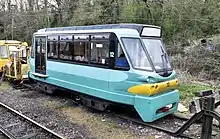| Parry People Movers | |
|---|---|
 PPM No. 35 at the Ecclesbourne Valley Railway, Wirksworth, Derbyshire | |
| Specifications | |
| Track gauge | 1,435 mm (4 ft 8+1⁄2 in) standard gauge |
Parry People Movers Ltd. (PPM) is a British company (founded by John Parry, who died 17 February 2023[1]) manufacturing lightweight trams and railcars that use flywheel energy storage (FES) to store energy for traction, allowing electric systems to operate without overhead wires or third rails, and railcars fuelled by small gas, diesel or hydrogen engines.
On 29 November 2022, The Registrar of Companies (UK) gave notice that Parry People Movers Ltd. would be struck off the Companies Register and dissolved unless "cause is shown to the contrary" though this was suspended on 7 December 2022.[2] The company has subsequently moved to voluntary liquidation 14 December 2023.[3]
Current usage
London Midland, then-owner of the West Midlands franchise, began operating a single PPM50 (Class 999) unit on the Stourbridge line on Sundays in 2006, with a Class 153 diesel multiple unit (DMU) providing a weekday service. In June 2009, the Class 153 was replaced by two PPM60 units, classified as Class 139 (with one as a spare), providing a 10-minute frequency service in both directions. Although the capacity of the unit (60 passengers) is less than the DMU, overall capacity is increased due to the greater frequency, up from four to six trains per hour. The trains were transferred to West Midlands Trains, operating under the West Midlands Railway brand, when the West Midlands franchise was refreshed in 2017.
From 24 January 2011, Go! Cooperative planned to be operating a trial service between Alton and Medstead and Four Marks on the Mid-Hants Railway using the Class 999 unit.[4] This was abandoned after a series of mechanical and electrical failures and due to the unit proving to be unsuitable for the long and steep gradients on the line.[5] The unit is now being reconfigured to address the problems with a redesigned chassis and conversion from LPG to diesel power and the trial will be repeated.[6][7]
In January 2012, plans emerged for new bigger PPMs to be used on the South Staffordshire Line between Stourbridge Junction and Brierley Hill, providing passenger services on the line for the first time since the Beeching Axe.[8]
Earlier trials

Prior to entry into commercial service, testing took place on the Severn Valley Railway in March and April 2002 with a PPM50 unit operating between Kidderminster and Bewdley.[9] The Parry flywheel storage technology was tested on the Stourbridge Town Branch Line in the West Midlands in 2006. Since Central Trains had no Sunday service on the branch, the initiative was brought to test a PPM50 model at that time, with a view to replacing the Class 153 single-car DMU that previously worked the Branch with a unit with much lower operating costs. The trial lasted for a year.
PPMs have also been demonstrated on narrow gauge railways (Welshpool and Llanfair Light Railway, Ffestiniog Railway, and Welsh Highland Railway).[10]
Technology
PPMs utilise a rotating flywheel as a store of kinetic energy which is then used to power the vehicle. A typical PPM flywheel is made from steel laminates, approximately 1 m (39 in) in diameter and 500 kg (1,100 lb) in mass, designed to rotate at a maximum speed of 2,500 rpm.[11] The flywheel is mounted horizontally at the centre of the unit, beneath the seating area. The flywheel is driven by an internal combustion engine or an electric motor. The flywheel is connected to the rail wheels via a hydrostatic variable transmission system.[12][13] The wheels are driven without conversion into electricity as many other railcars utilising flywheel energy storage do.[14]
The flywheel allows the direct capture of brake energy (when slowing down or descending gradients) and its reuse for acceleration (called regenerative braking). When the vehicle brakes, the hydrostatic transmission feeds the energy back into the flywheel. Since the short-term power demand for acceleration is provided by the energy stored in the flywheel, there is no need for a large engine. A variety of small engine types can be used including LPG, diesel or electric traction.
On a route with stations a short distance apart it is theoretically possible to use the unit as a tram without any engine or overhead electrification at all. Instead, the flywheel could be re-energised at each station, storing enough power to carry it on to the next.
Fleet
| Class | Operator | No. Built | Year Built | Cars per Set | Unit nos. | Carriage nos. | Length | Seated | Standing |
|---|---|---|---|---|---|---|---|---|---|
| Class 139 | Pre-Metro Operations on behalf of West Midlands Railway | 2 | 2008 | 1 | 139001 - 139002 | 39001 - 39002 | 9.6 m | 25 | 35 |
| Class 999 | Pre-Metro Operations | 1 | 2002 | 1 | 999900 | 999900 | 8.7 m | 20 | 30 |
In April 2019, PPM announced plans to upgrade the original Class 999 PPM50 prototype with a diesel power unit and to seek approval for its entry into passenger service as 'No 139000'.[15] In February 2020, the refurbished vehicle was moved to the Severn Valley Railway for testing.

See also
References
- ↑ "Obituary in RAIL". Rail Magazine.
- ↑ "PARRY PEOPLE MOVERS LIMITED filing history - Find and update company information - GOV.UK".
- ↑ "Resolutions for Winding-up - PARRY PEOPLE MOVERS LIMITED, The Gazette, 18 Dec 2023".
- ↑ (retrieved 18 January 2011)
- ↑ "Latest News". Watercress Line. Archived from the original on 17 May 2011. Retrieved 19 January 2011.
- ↑ "Newsletter May 2011" (PDF). Lightweight Community Transport. May 2011. Archived from the original (PDF) on 26 April 2012. Retrieved 30 December 2011.
- ↑ "A brand new railcar is being built for Mid Hants – and local residents are invited to become part owners" (PDF). Lightweight Community Transport (Press release). 21 October 2011. Archived from the original (PDF) on 26 April 2012. Retrieved 12 April 2012.
- ↑ "Cradley Heath firm releases new images of proposed light rail link". Halesowen News.
- ↑ Severn Valley Railway News, Issue 140, Summer 2002, p. 53.
- ↑ Welsh Highland Railway Society web site
- ↑ "PPM Technology". Parry People Movers. Archived from the original on 28 December 2017. Retrieved 13 October 2008.
The rotating flywheel is a store of kinetic energy that is used to power the vehicle. A typical PPM flywheel is made from steel laminates, 1 m (39 in) in diameter and 500 kg (1,100 lb) mass, rotating at a maximum speed of 2,500rpm
- ↑ "Two Axle Vehicles". Parry People Movers. Archived from the original on 4 August 2020. Retrieved 28 May 2020.
- ↑ Luvishis, Aleksandrv (2009v). Hybrid rail vehicles. Lulu.com. p. 67. ISBN 978-0-578-04577-1. OCLC 698081929.
- ↑ Simpson, Barry J. (1994). Urban public transport today (1st ed.). London: E & FN Spon. p. 32. ISBN 0-203-36223-3. OCLC 252870686.
- ↑ Parry News Issue 76, April 2019, p. 6. Archived 29 February 2020 at the Wayback Machine Retrieved 29 February 2020.
External links
- "Parry People Movers Official website". Archived from the original on 26 May 2022.
- "First Notice of compulsory strike-off from Companies Register - Parry People Movers".
- "Revolutionary tram notches up 500,000 passengers". Stourbridge News. 31 August 2010. Retrieved 2 May 2023.